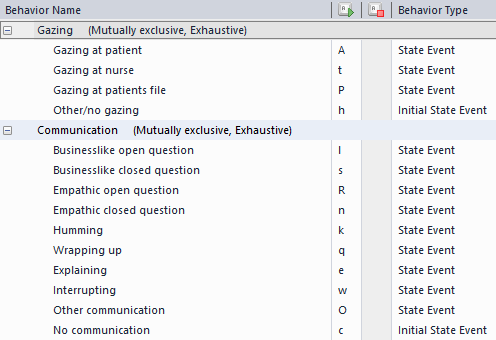Behavior Groups
Bibiana mentions in the video that behaviors which cannot occur at the same time need to be put in one Behavior Group. Take gazing behavior, for example. When the doctor gazes at the patient, he cannot gaze at the nurse or the patient file at the same time. In the Coding Scheme, these gazing behaviors are put in one Behavior Group and defined as mutually exclusive. This means in practice that when you code a gazing behavior, the previously active gazing behavior stops automatically.
While the doctor is gazing at patient, nurse or patient file, the doctor can at the same time communicate with the patient or nurse. Therefore, communication behavior is added in a separate Behavior Group (also defined as mutually exclusive). Below you can see the two Behavior groups gazing and communication set up in the Coding Scheme.
Please note that in a mutually exclusive Behavior Group there must always be an ‘Initial State Event’; this is the behavior which is automatically scored/active when you start the Observation. In the example below, the Initial State Events are ‘Other/no gaze’ and ‘No communication’.
When a Behavior Group is defined as mutually exclusive and exhaustive, it means that behaviors cannot be stopped so there is always a behavior active within a Behavior Group. In an exhaustive group, there are no stop key codes.

The resulting visualization of the coded/annotated gazing and communication behaviors of the doctor is shown below. You can see that the gazing behaviors do not overlap, i.e., they do not occur at the same time. The same applies to the communication behaviors. However, gazing does overlap with communication behaviors.

Video transcript
If you prefer to read, click on the button below to check out the video transcript.
Show video transcript